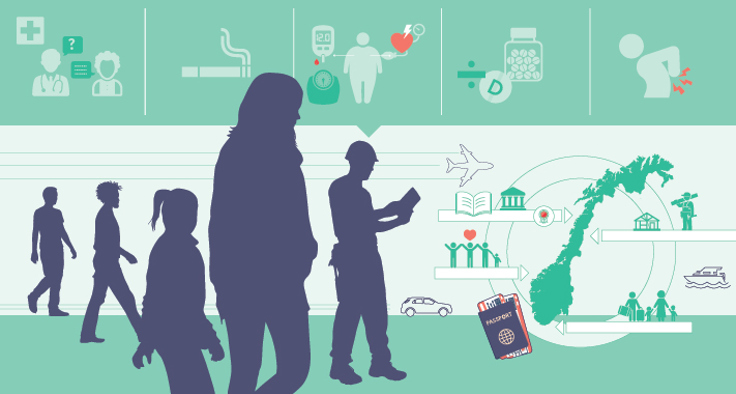Health in the immigrant population
Published
|This article is a summary of the Norwegian article about health and disease in the immigrant population, as well as risk and protective factors.
By the beginning of 2018, immigrants and the children of immigrants constituted around 17 per cent of the population of Norway, a total of around 920 000 people (Statistics Norway, 2018b). Around 49 per cent had a background from Europe (excluding Turkey), while 46 per cent had backgrounds from Africa or Asia.
Since 1990, approximately a third of immigrants came to Norway for work, 36 per cent for family reunification, 20 per cent for refuge and 10 per cent for education (Statistics Norway, 2017a).
Country background
Previously, immigrants came mainly from Africa, Asia and Western Europe, but in recent decades there has been a large immigration from EU countries in Eastern Europe, mainly labour immigration.
Over half of immigrants come from Europe. Among Norwegian-born with immigrant parents, approximately 65 per cent have an Asian or African background. The immigrant population represents more than 220 countries, see table 1.
|
|
Number of immigrants |
Number of Norwegian-born with immigrant parents |
|
Europe (EU 28/EEA countries) |
330 619 |
38 503 |
|
European countries outside EU 28/EEA countries |
59 756 |
17 375 |
|
Africa |
93 735 |
33 420 |
|
Asia (incl. Turkey) |
227 631 |
76 411 |
|
North America |
10 580 |
824 |
|
South and Central America |
22 171 |
3 348 |
|
Oceania |
2 169 |
83 |
|
Total |
746 661 |
169 964 |
Source: Statistics Norway
Age
The immigrant population is younger than the general population. Over half of immigrants are in the 20-44 year age group, compared to a third of the general population (Henriksen, Østby and Ellingsen, 2010). In the group of Norwegian-born with immigrant parents, 70 per cent are under 15-years-old.
Education
There are large variations in education level by country background. A major proportion of people from Afghanistan, Somalia, Iraq and Eritrea, among other countries, have little or no education, whereas immigrants from Western Europe, North America and Oceania often have a higher education (Statistics Norway, 2017b).
- Among immigrants, 10 per cent have more than four years of university education compared to 8 per cent of the general population.
- Approximately 8 600 immigrants, particularly women, have not completed lower secondary education (Steinkellner, 2012).
Income
Immigrants are over-represented in low-income groups and immigrants from Asia, Africa, Latin America, Oceania excluding Australia and New Zealand, and Europe excluding EU/EEA have lower employment than the general population (Statistics Norway, 2018b).
In general, immigrants are as satisfied with life as the rest of the population and immigrants are less ill and use health services to a lesser extent than the rest of the population. However, there are major differences between groups. Health varies with country of origin, reason for immigration and length of stay in Norway.
Immigrant health in general
The immigrant population is a compilation of diverse groups with different genetic backgrounds, risk factors and immigration history, which all affect their health. Their health needs also change with length of stay.
Socioeconomic status also has an impact on health within the immigrant groups. Physical and mental health is better among those who have a high education, who are employed or have good personal finances (Abebe, 2014; Levecque, 2015; Thøgersen, 2017).
Good social support and social integration are associated with good health, whereas perceived discrimination and violence have a negative impact (Abebe, 2014; Levecque, 2015; Noam, 2014; Oppedal, 2015).
Mental health
As many immigrants as people in the rest of the population report that they are satisfied with life (Koots-Ausmees, 2016), according to studies that use data from several European countries, including Norway. Nevertheless, a higher proportion of immigrants report mental health problems, especially from countries outside Europe, (Statistics Norway, 2017c; Dalgard, 2007; Dalgard, 2006).
The risk of mental disorders is linked to lower socioeconomic status, experiencing differential treatment due to immigrant backgrounds, language barriers and other negative life events (Abebe, 2014; Levecque, 2015).
Refugees consult GPs for mental disorders to a somewhat higher extent than the rest of the population (Straiton, 2016).
It is currently uncertain whether mental disorders are more prevalent among children and adolescents with immigrant backgrounds than in the rest of the population (Abebe, 2014; Noam, 2014; NOVA, 2015; NIPH, 2008); different studies produce somewhat different results. However, it is estimated that around half of unaccompanied refugee minors have symptoms of post-traumatic stress disorder upon or after arrival in Norway (Jakobsen, 2014; Jensen, 2015).
Physical health
Physical diseases among immigrants, as for the general population, are primarily non-communicable diseases. Certain groups are at particular risk:
- Diabetes is widespread among immigrants from Sri Lanka and Pakistan, with 20–24 per cent of adults aged 30–59 affected, compared to 3–6 per cent in the rest of the population (Jenum, 2012a). Women from countries with a high incidence of diabetes have an especially high risk of developing gestational diabetes (Jenum, 2012b).
- Immigrants from Eastern Europe have a higher risk of developing lung cancer and stomach cancer than the rest of the population (Hjerkind, 2017).
- Cardiovascular disease is more widespread among immigrants from Southern Asia and the Balkans than in the general population (Rabanal, 2013; Rabanal 2015). Around 20–25 per cent of immigrants from Turkey, Iraq and Pakistan are obese. The same applies to Somalian women, according to self-reported figures for height and weight (Statistics Norway, 2017)
- Vitamin D deficiency is widespread among immigrants from countries outside Europe, especially the Middle East, Sub-Saharan Africa and South Asia, where around three in five people have vitamin D deficiency (Eggemoen, 2013).
Some immigrant groups have a higher incidence of certain infectious diseases than the general population, of which the majority are infected in their country of origin. Most of the new annual cases of tuberculosis and hepatitis B occur among immigrants. The same also applies to one half of new HIV cases (NIPH 2016b).
Lifestyle factors
Immigrants in general and the adult children of immigrants from countries outside Europe drink less alcohol than the general population. For example, one in five adolescents in Oslo with an immigrant background had consumed beer in the last month compared to about one half of those without an immigrant background (NOVA, 2012).
In several immigrant groups, there is still a considerable proportion who smoke daily. The average among immigrant men was 36 per cent, compared to 22 per cent among men in the general population, according to figures from Statistic Norway's survey. Around 45 per cent of immigrant men from Poland, Kosovo, Turkey and Vietnam smoked on a daily basis. Among women, the figures are much lower (Statistics Norway, 2017).
Knowledge of immigrant health and use of health services has increased in recent years, but is still lacking.

